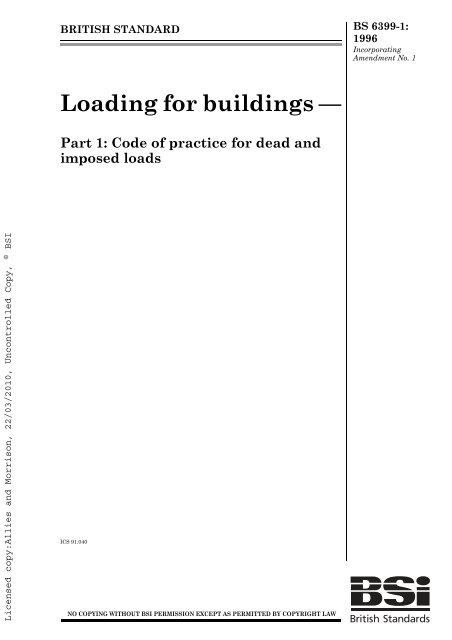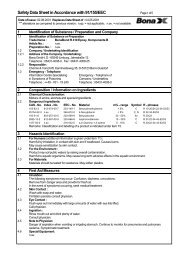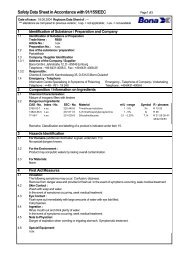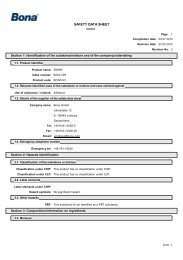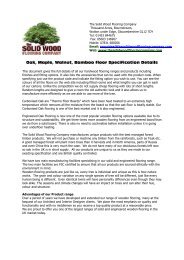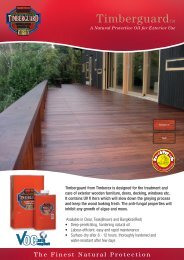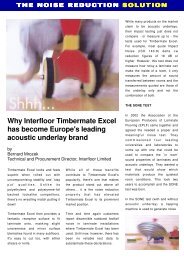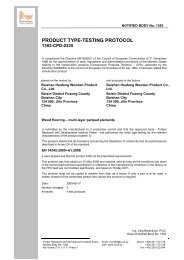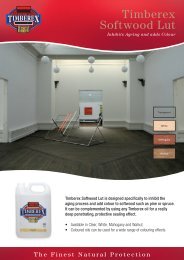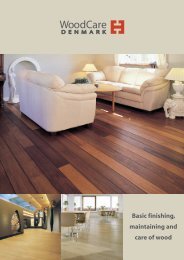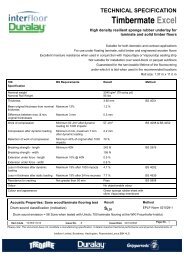Loading for buildings â - Solid Wood Flooring Company
Loading for buildings â - Solid Wood Flooring Company
Loading for buildings â - Solid Wood Flooring Company
Create successful ePaper yourself
Turn your PDF publications into a flip-book with our unique Google optimized e-Paper software.
BRITISH STANDARD BS 6399-1:<br />
1996<br />
Incorporating<br />
Amendment No. 1<br />
<strong>Loading</strong> <strong>for</strong> <strong>buildings</strong> —<br />
Part 1: Code of practice <strong>for</strong> dead and<br />
imposed loads<br />
Licensed copy:Allies and Morrison, 22/03/2010, Uncontrolled Copy, © BSI<br />
ICS 91.040
BS 6399-1:1996<br />
Committees responsible <strong>for</strong> this<br />
British Standard<br />
The preparation of this British Standard was entrusted by Technical<br />
Committee B/525, Building and civil engineering structures, to Subcommittee<br />
B/525/1, Actions (loadings) and basis of design, upon which the following bodies<br />
were represented:<br />
Licensed copy:Allies and Morrison, 22/03/2010, Uncontrolled Copy, © BSI<br />
This British Standard, having<br />
been prepared under the<br />
direction of the Sector Board<br />
<strong>for</strong> Building and Civil<br />
Engineering, was published<br />
under the authority of the<br />
Standards Board and comes<br />
into effect on<br />
15 September 1996<br />
© BSI 11 October 2002<br />
First published February 1984<br />
Second edition September 1996<br />
The following BSI references<br />
relate to the work on this<br />
standard:<br />
Committee reference B/525/1<br />
Draft <strong>for</strong> comment 95/100935 DC<br />
ISBN 0 580 26239 1<br />
British Constructional Steelwork Association Ltd.<br />
British Iron and Steel Producers Association<br />
British Masonry Society<br />
Concrete Society<br />
Department of the Environment (Building Research Establishment)<br />
Department of the Environment (Property and Buildings Directorate)<br />
Department of Transport (Highways Agency)<br />
Institution of Structural Engineers<br />
National House-building Council<br />
Royal Institute of British Architects<br />
Steel Construction Institute<br />
Co-opted members<br />
Amendments issued since publication<br />
Amd. No. Date Comments<br />
13669 11 October 2002 See national <strong>for</strong>eword
BS 6399-1:1996<br />
Contents<br />
Committees responsible<br />
Foreword<br />
Page<br />
Inside front cover<br />
ii<br />
Licensed copy:Allies and Morrison, 22/03/2010, Uncontrolled Copy, © BSI<br />
1 Scope 1<br />
2 References 1<br />
3 Definitions 1<br />
4 Dead loads 2<br />
5 Imposed floor and ceiling loads 2<br />
6 Reduction in total imposed floor loads 6<br />
7 Imposed roof loads 7<br />
8 Crane gantry girders 7<br />
9 Text deleted<br />
10 Parapets, barriers and balustrades 7<br />
11 Vehicle barriers <strong>for</strong> car parks 8<br />
12 Accidental load on key or protected elements 9<br />
Annex A (in<strong>for</strong>mative) Examples of dynamic loading conditions <strong>for</strong> some specific<br />
structural types 10<br />
Table 1 — Minimum imposed floor loads 3<br />
Table 2 — Reduction in total distributed imposed floor loads with number of<br />
storeys 7<br />
Table 3 — Reduction in total distributed imposed floor loads on a supporting<br />
beam or girder with floor area 7<br />
Table 4 — Minimum horizontal imposed loads <strong>for</strong> parapets, barriers and balustrades,<br />
etc. 9<br />
List of references (see clause 2) 11<br />
© BSI 11 October 2002<br />
i
BS 6399-1:1996<br />
Foreword<br />
Licensed copy:Allies and Morrison, 22/03/2010, Uncontrolled Copy, © BSI<br />
This Part of BS 6399 has been prepared by Subcommittee B/525/1, Actions<br />
(loadings) and basis of design. It supersedes BS 6399-1:1984, which is withdrawn.<br />
This edition of BS 6399-1, introduces technical changes, but it does not reflect a<br />
full revision of the standard which will be undertaken in due course.<br />
The start and finish of text introduced or altered by Amendment No. 1 is indicated<br />
in the text by tags .<br />
The principal change in this edition is the presentation of the imposed floor loads<br />
according to the type of activity/occupancy, rather than occupancy class as<br />
introduced in the 1984 edition. The weights of movable partitions which were<br />
redefined as imposed loads in the 1984 edition, retain their classification. The<br />
reductions in floor load with number of storeys and with area have also been<br />
clarified.<br />
Table 1 and Table 4 have been revised by amendment to limit the guidance to<br />
types of <strong>buildings</strong> and structures appropriate to the scope of this standard.<br />
Consequently, loading in<strong>for</strong>mation relevant to grandstands and designated<br />
stadia had been removed and reference is made to the requirements of the<br />
appropriate certifying authorities.<br />
Clause 9, on dynamic loading, has been deleted and an amended version of the<br />
clause has been introduced as an in<strong>for</strong>mative Annex A. This was necessary in<br />
order to limit the guidance given in this standard to the types of <strong>buildings</strong> and<br />
structures covered in the scope of this Part of BS 6399 but at the same time<br />
provide references to specialist guidance <strong>for</strong> the design of structures susceptible<br />
to dynamic excitation. The deletion of Clause 9 has led to the removal of the<br />
normative Annex A on dynamic loads <strong>for</strong> dancing and jumping. That annex was<br />
intended to provide a rigorous approach to the evaluation of dynamic loading,<br />
which could only be applied in conjunction with specialist guidance, which is<br />
undergoing further development.<br />
Clause 10 has been revised to give new recommendations <strong>for</strong> vertical loading on<br />
parapets, barriers and balustrades.<br />
The basis of the loadings is historical and they agree, subject to comparatively<br />
minor variations, with international consensus of opinion.<br />
The data on wind loads are given in BS 6399-2 and data on imposed roof loads are<br />
given in BS 6399-3.<br />
In this edition of BS 6399-1, numerical values have been given in terms of<br />
SI units, details of which are to be found in BS 5555. Those concerned with the<br />
conversion and renovation of older <strong>buildings</strong> designed in terms of imperial units<br />
may find it useful to note that 1 N = 0.225 lbf and 1 kN/m 2 = 20.89 lbf/ft 2 .<br />
A British Standard does not purport to include all the necessary provisions of a<br />
contract. Users of British Standards are responsible <strong>for</strong> their correct application.<br />
Compliance with a British Standard does not of itself confer immunity<br />
from legal obligations.<br />
Summary of pages<br />
This document comprises a front cover, an inside front cover, pages i and ii,<br />
pages 1 to 11 and a back cover.<br />
The BSI copyright notice displayed in this document indicates when the<br />
document was last issued.<br />
ii © BSI 11 October 2002
BS 6399-1:1996<br />
1 Scope<br />
Licensed copy:Allies and Morrison, 22/03/2010, Uncontrolled Copy, © BSI<br />
1.1 This Part of BS 6399 gives dead and minimum recommended imposed loads <strong>for</strong> use in designing<br />
<strong>buildings</strong>. It applies to:<br />
a) new <strong>buildings</strong> and new structures;<br />
b) alterations and additions to existing <strong>buildings</strong> and existing structures;<br />
c) existing construction on change of use.<br />
It does not apply to the maintenance of, or the replacement of parts of, existing <strong>buildings</strong> and structures<br />
where there is no change of use.<br />
1.2 This code of practice does not give recommendations <strong>for</strong>:<br />
a) loads on road and rail bridges, as these are dealt with in other British Standards, e.g. BS 5400;<br />
b) wind loads (see BS 6399-2);<br />
c) imposed roof loads (see BS 6399-3);<br />
d) snow loads (see BS 6399-3);<br />
e) loads on structures subject to internal pressures from their contents (e.g. bunkers, silos and water<br />
tanks), which have to be calculated individually;<br />
f) loads on <strong>buildings</strong> and structures susceptible to dynamic excitation;<br />
NOTE General guidance is given in Clause 5, Note 1, Note 2 and Note 3.<br />
g) loads due to lifts (see BS 2655);<br />
h) loads incidental to construction;<br />
i) test loads;<br />
j) loads <strong>for</strong> crane gantry girders (see BS 2573).<br />
k) loads on grandstands and stadia<br />
NOTE General guidance is given in Table 1, Note 4.<br />
2 References<br />
2.1 Normative references<br />
This Part of BS 6399 incorporates, by dated or undated reference, provisions from other publications. These<br />
normative references are made at the appropriate places in the text and the cited publications are listed on<br />
the inside back cover. For dated references, only the edition cited applies, any subsequent amendments to<br />
or revisions of the cited publication apply to this Part of BS 6399 only when incorporated in the reference<br />
by amendment or revision. For undated references, the latest edition of the cited publication applies,<br />
together with any amendments.<br />
2.2 In<strong>for</strong>mative references<br />
This Part of BS 6399 refers to other publications that provide in<strong>for</strong>mation or guidance. Editions of these<br />
publications current at the time of issue of this standard are listed on the inside back cover, but reference<br />
should be made to the latest editions.<br />
3 Definitions<br />
For the purposes of this code of practice the following definitions apply.<br />
3.1<br />
dead load<br />
the load due to the weight of all walls, permanent partitions, floors, roofs, finishes and all other permanent<br />
construction including services of a permanent nature<br />
3.2<br />
imposed load<br />
the load assumed to be produced by the intended occupancy or use, including the weight of movable<br />
partitions, distributed, concentrated, impact and inertia, loads, but excluding wind loads<br />
© BSI 11 October 2002<br />
1
BS 6399-1:1996<br />
Licensed copy:Allies and Morrison, 22/03/2010, Uncontrolled Copy, © BSI<br />
3.3<br />
storage height<br />
the height of the space between a floor and a physical constraint to the height of storage <strong>for</strong>med by a ceiling,<br />
soffit of a floor, roof or other obstruction<br />
3.4<br />
wind load<br />
the load due to the effect of wind pressure or suction<br />
3.5<br />
accidental load on key or protected element<br />
the ultimate load assumed, during a single accidental loading event to apply to structural elements<br />
essential to the residual stability of the building<br />
4 Dead loads<br />
Dead loads are calculated from the unit weights given in BS 648 or from the actual known weights of the<br />
materials used. Where there is doubt as to the permanency of dead loads, such loads should be treated as<br />
imposed loads.<br />
Where permanent partitions are indicated, their actual weights are included in the dead load.<br />
The weights of tanks and other receptacles, and of their contents, are considered as dead loads. These loads<br />
should be calculated <strong>for</strong> the cases when a tank or receptacle is full and when it is empty.<br />
5 Imposed floor and ceiling loads<br />
NOTE 1 The imposed loads given in this clause are intended to be treated as static loads. They include allowances <strong>for</strong> nominal<br />
dynamic effects expected <strong>for</strong> the type of occupancy or activity stated that are appropriate <strong>for</strong> the static load design of most <strong>buildings</strong><br />
and structures.<br />
However, static load design is not sufficient where dynamic loading occurs in <strong>buildings</strong> and structures that are susceptible to dynamic<br />
excitation. In such cases, the design should take account of the load-structure interaction and natural frequency, mass, damping and<br />
mode shape of the structure.<br />
Furthermore, <strong>for</strong> structural design with oscillation or vibration as a serviceability criterion, separate considerations are necessary,<br />
e.g. the operation of equipment and the com<strong>for</strong>t of users and occupiers of a building.<br />
NOTE 2 For public <strong>buildings</strong> and structures, such as those intended <strong>for</strong> providing spectator facilities, the certifying authority may<br />
refer to specific guidance documents as appropriate <strong>for</strong> compliance with their requirements.<br />
NOTE 3 General advice on dynamic loading conditions <strong>for</strong> some specific structural types are given in Annex A.<br />
5.1 Floors<br />
5.1.1 General<br />
The loads appropriate to the type of activity/occupancy <strong>for</strong> which the floor area will be used in service are<br />
given in Table 1. The loads in Table 1 should be treated as the unfactored or characteristic loads <strong>for</strong> design<br />
purposes.<br />
They should be considered as the minimum values to be adopted.<br />
Where higher values are considered more appropriate, based on a knowledge of the proposed use of the<br />
structure or proposed installation of equipment, machinery, stacking systems, etc., they should be used<br />
instead.<br />
All floors should be designed to carry the uni<strong>for</strong>mly distributed or concentrated load, whichever produces<br />
the greatest stresses (or where critical, deflection) in the part of the floor under consideration.<br />
The categories adopted <strong>for</strong> types of activity/occupancy are:<br />
A<br />
B<br />
C<br />
D<br />
E<br />
F/G<br />
Domestic and residential activities<br />
Office and work areas not covered elsewhere<br />
Areas where people may congregate<br />
Shopping areas<br />
Areas susceptible to the accumulation of goods<br />
Vehicle and traffic areas<br />
2 © BSI 11 October 2002
BS 6399-1:1996<br />
Table 1 — Minimum imposed floor loads<br />
Licensed copy:Allies and Morrison, 22/03/2010, Uncontrolled Copy, © BSI<br />
Type of<br />
activity/occupancy <strong>for</strong><br />
part of the building or<br />
structure<br />
A Domestic and residential<br />
activities<br />
(Also see category C)<br />
B Offices and work areas<br />
not covered elsewhere<br />
Examples of specific use<br />
All usages within self-contained single<br />
family dwelling units<br />
Communal areas (including kitchens) in blocks of<br />
flats with limited use (See note 1) (For communal<br />
areas in other blocks of flats, see C3 and below)<br />
Bedrooms and dormitories except those in<br />
single family dwelling units and in hotels<br />
and motels<br />
Bedrooms in hotels and motels<br />
Hospital wards<br />
Toilet areas<br />
Uni<strong>for</strong>mly distributed<br />
load<br />
Concentrated load<br />
© BSI 11 October 2002<br />
3<br />
kN/m 2<br />
1.5 1.4<br />
1.5 1.8<br />
2.0 1.8<br />
Billiard rooms 2.0 2.7<br />
Communal kitchens except in flats covered by 3.0 4.5<br />
note 1<br />
Balconies<br />
Single<br />
family<br />
dwelling units<br />
and communal<br />
areas in blocks of<br />
flats with limited<br />
use (See note 1)<br />
1.5 1.4<br />
Guest houses,<br />
residential clubs<br />
and communal<br />
areas in blocks of<br />
flats except as<br />
covered by note 1<br />
Hotels and<br />
motels<br />
Same as rooms to which<br />
they give access but with<br />
a minimum of 3.0<br />
Same as rooms to which<br />
they give access but with<br />
a minimum of 4.0<br />
kN<br />
1.5/m run concentrated<br />
at the outer edge<br />
1.5/m run concentrated<br />
at the outer edge<br />
Operating theatres, X-ray rooms, utility rooms 2.0 4.5<br />
Work rooms (light industrial) without storage 2.5 1.8<br />
Offices <strong>for</strong> general use 2.5 2.7<br />
Banking halls 3.0 2.7<br />
Kitchens, laundries, laboratories 3.0 4.5<br />
Rooms with mainframe computers or similar 3.5 4.5<br />
equipment<br />
Machinery halls, circulation spaces therein 4.0 4.5<br />
Projection rooms 5.0 To be determined <strong>for</strong><br />
specific use<br />
Factories, workshops and similar <strong>buildings</strong> 5.0 4.5<br />
(general industrial)<br />
Foundries 20.0 To be determined <strong>for</strong><br />
specific use<br />
Catwalks — 1.0 at 1 m centres<br />
Balconies<br />
Same as rooms to which<br />
they give access but with<br />
1.5/m run concentrated<br />
at the outer edge<br />
a minimum of 4.0<br />
Fly galleries<br />
4.5 kN/m run<br />
distributed uni<strong>for</strong>mly<br />
over width<br />
—<br />
Ladders — 1.5 rung load
BS 6399-1:1996<br />
Table 1 — Minimum imposed floor loads (continued)<br />
Licensed copy:Allies and Morrison, 22/03/2010, Uncontrolled Copy, © BSI<br />
Type of<br />
activity/occupancy <strong>for</strong><br />
part of the building or<br />
structure<br />
C Areas where people may<br />
congregate<br />
Examples of specific use<br />
Public, institutional and communal dining rooms and<br />
lounges, cafes and restaurants (See note 2)<br />
Uni<strong>for</strong>mly distributed<br />
load<br />
Concentrated load<br />
4 © BSI 11 October 2002<br />
kN/m 2<br />
2.0 2.7<br />
C1 Areas with tables Reading rooms with no book storage 2.5 4.5<br />
Classrooms 3.0 2.7<br />
C2 Areas with fixed seats Assembly areas with fixed seating (See note 3) 4.0 3.6<br />
Places of worship 3.0 2.7<br />
C3 Areas without<br />
obstacles <strong>for</strong> moving<br />
people<br />
C4 Areas with possible<br />
physical activities<br />
(See clause 5, Note 1,<br />
Note 2 and Note 3)<br />
C5 Areas susceptible to<br />
overcrowding<br />
(See clause 5, Note 1,<br />
Note 2 and Note 3)<br />
Corridors, hallways, aisles, stairs,<br />
landings etc. in institutional type<br />
<strong>buildings</strong> (not subject to crowds or<br />
wheeled vehicles), hostels, guest<br />
houses, residential clubs, and<br />
communal areas in blocks of flats<br />
not covered by note 1. (For<br />
communal areas in blocks of flats<br />
covered by note 1, see A)<br />
Corridors, hallways, aisles, stairs,<br />
landings, etc. in all other<br />
<strong>buildings</strong> including hotels and<br />
motels and institutional <strong>buildings</strong><br />
Corridors,<br />
hallways,<br />
aisles etc.<br />
(foot traffic only)<br />
Stairs and<br />
landings<br />
(foot traffic only)<br />
Corridors,<br />
hallways, aisles,<br />
etc.<br />
(foot traffic only)<br />
Corridors,<br />
hallways, aisles,<br />
etc., subject to<br />
wheeled vehicles,<br />
trolleys etc.<br />
Stairs and<br />
landings<br />
(foot traffic only)<br />
Light duty walkways — (access suitable <strong>for</strong> one<br />
person, walkway width approximately 600 mm)<br />
General duty walkways — (regular two-way<br />
pedestrian traffic)<br />
Heavy duty walkways — (high density pedestrian<br />
traffic including escape routes)<br />
Museum floors and art galleries <strong>for</strong> exhibition<br />
purposes<br />
Balconies (except as specified in A)<br />
Fly galleries<br />
3.0 4.5<br />
3.0 4.0<br />
4.0 4.5<br />
5.0 4.5<br />
4.0 4.0<br />
3.0 2.0<br />
5.0 3.6<br />
7.5 4.5<br />
4.0 4.5<br />
Same as rooms to which<br />
they give access but with<br />
a minimum of 4.0<br />
4.5 kN/m run<br />
distributed uni<strong>for</strong>mly<br />
over width<br />
Dance halls and studios, gymnasia, stages 5.0 3.6<br />
Drill halls and drill rooms 5.0 9.0<br />
Assembly areas without fixed seating, concert halls, 5.0 3.6<br />
bars and places of worship (See Note 4)<br />
Stages in public assembly areas 7.5 4.5<br />
D Shopping areas Shop floors <strong>for</strong> the sale and display of merchandise 4.0 3.6<br />
kN<br />
1.5/m run<br />
concentrated at the<br />
outer edge<br />
—
BS 6399-1:1996<br />
Table 1 — Minimum imposed floor loads (concluded)<br />
Licensed copy:Allies and Morrison, 22/03/2010, Uncontrolled Copy, © BSI<br />
Type of<br />
activity/occupancy <strong>for</strong><br />
part of the building or<br />
structure<br />
E Warehousing and<br />
storage areas. Areas<br />
subject to accumulation of<br />
goods. Areas <strong>for</strong><br />
equipment and plant.<br />
F<br />
G<br />
Examples of specific use<br />
Uni<strong>for</strong>mly distributed<br />
load<br />
kN/m 2<br />
General areas <strong>for</strong> static equipment not specified 2.0 1.8<br />
elsewhere (institutional and public <strong>buildings</strong>)<br />
Reading rooms with book storage, e.g. libraries 4.0 4.5<br />
General storage other than those specified 2.4 <strong>for</strong> each metre of 7.0<br />
storage height<br />
File rooms, filing and storage space (offices) 5.0 4.5<br />
Stack rooms (books)<br />
2.4 <strong>for</strong> each metre in<br />
storage height but with a<br />
minimum of 6.5<br />
7.0<br />
Paper storage <strong>for</strong> printing plants and stationery<br />
stores<br />
Dense mobile stacking (books) on mobile trolleys,<br />
in public and institutional <strong>buildings</strong><br />
Dense mobile stacking (books) on mobile trucks,<br />
in warehouses<br />
Cold storage<br />
4.0 <strong>for</strong> each metre of<br />
storage height<br />
4.8 <strong>for</strong> each metre of<br />
storage height but with a<br />
minimum of 9.6<br />
4.8 <strong>for</strong> each metre of<br />
storage height but with a<br />
minimum of 15.0<br />
5.0 <strong>for</strong> each metre of<br />
storage height but with a<br />
minimum of 15.0<br />
Concentrated load<br />
Plant rooms, boiler rooms, fan rooms, etc., 7.5 4.5<br />
including weight of machinery<br />
Ladders — 1.5 rung load<br />
Parking <strong>for</strong> cars, light vans, etc. not<br />
2.5 9.0<br />
exceeding 2500 kg gross mass, including<br />
garages, driveways and ramps<br />
Vehicles exceeding 2500 kg. Driveways, ramps,<br />
repair workshops, footpaths with vehicle access,<br />
and car parking<br />
© BSI 11 October 2002<br />
5<br />
9.0<br />
7.0<br />
7.0<br />
9.0<br />
To be determined <strong>for</strong> specific use<br />
NOTE 1 Communal areas in blocks of flats with limited use refers to blocks of flats not more than three storeys in height and with<br />
not more than four self-contained single family dwelling units per floor accessible from one staircase.<br />
NOTE 2 Where these same areas may be subjected to loads due to physical activities or overcrowding, e.g. a hotel dining room<br />
used as a dance floor, imposed loads should be based on occupancy C4 or C5 as appropriate. Reference should also be made to<br />
Clause 5, Note 1, Note 2 and Note 3.<br />
NOTE 3<br />
NOTE 4<br />
Fixed seating is seating where its removal and the use of the space <strong>for</strong> other purposes is improbable.<br />
For grandstands and stadia, see the requirements of the appropriate certifying authority.<br />
kN
BS 6399-1:1996<br />
Licensed copy:Allies and Morrison, 22/03/2010, Uncontrolled Copy, © BSI<br />
5.1.2 Uni<strong>for</strong>mly distributed loads<br />
The uni<strong>for</strong>mly distributed loads given in Table 1 are the uni<strong>for</strong>mly distributed static loads per square<br />
metre of plan area and provide <strong>for</strong> the effects of normal use.<br />
5.1.3 Concentrated loads<br />
Concentrated loads should be assumed to act at points on the member to give the greatest moment, shear<br />
(or where critical, deflection). Concentrated loads should be applied to individual members and assumed to<br />
act on them unless there is evidence that adequate interaction exists to ensure that the load can be shared<br />
or spread.<br />
When used <strong>for</strong> the calculation of local effects such as crushing and punching, the concentrated loads should<br />
be assumed to act at a position and over an area of application appropriate to their cause.<br />
Where this cannot be <strong>for</strong>eseen, a square contact area with a 50 mm side should be assumed.<br />
5.1.4 Partitions<br />
When permanent partitions are indicated, their weight should be included in the dead load, acting at the<br />
given partition location.<br />
In <strong>buildings</strong> where the use of other partitions is envisaged, an additional imposed load should be specified<br />
<strong>for</strong> the floor area. This may be taken as a uni<strong>for</strong>mly distributed load of not less than one third of the load<br />
per metre run of the finished partitions. For floors of offices, this additional uni<strong>for</strong>mly distributed partition<br />
load should not be less than 1.0 kN/m 2 .<br />
5.2 Ceiling supports and similar structures<br />
The following loads are appropriate <strong>for</strong> the design of frames and covering of access hatches (other than<br />
glazing), supports of ceilings and similar structures:<br />
a) without access: no imposed load; or<br />
b) with access: 0.25 kN/m 2 uni<strong>for</strong>mly distributed over the whole area and a concentrated load of 0.9 kN<br />
so placed as to produce the maximum effect in the supporting members.<br />
6 Reduction in total imposed floor loads<br />
6.1 The following do not qualify <strong>for</strong> reduction:<br />
a) loads that have been specifically determined from a knowledge of the proposed use of the structure;<br />
b) loads due to plant or machinery;<br />
c) loads due to storage.<br />
Otherwise, floors designed <strong>for</strong> activities described in categories A to D inclusive in Table 1 may qualify <strong>for</strong><br />
the reductions specified in this clause to be applied to the uni<strong>for</strong>mly distributed floor loads given in Table 1.<br />
6.2 Reduction in loading on columns<br />
The reductions given in Table 2 (based on the number of floors qualifying <strong>for</strong> load reduction carried by the<br />
member under consideration) may be applied to the total imposed floor load in the design of columns, piers,<br />
walls and their supports and foundations, except as provided in 6.1. The percentage reductions given apply<br />
to the total distributed imposed load (including the additional uni<strong>for</strong>mly distributed imposed partition<br />
load, see 5.1.4) on all floors qualifying <strong>for</strong> reduction carried by the member under consideration.<br />
Alternatively, the reductions based on area in 6.3 may be applied but the reductions given in Table 2 cannot<br />
be used in combination with those in Table 3.<br />
NOTE The moments on a column should be determined from the load used to design the beams at the appropriate level and not<br />
reduced on the same basis as the axial load.<br />
6 © BSI 11 October 2002
BS 6399-1:1996<br />
Table 2 — Reduction in total distributed imposed floor loads with number of storeys<br />
Licensed copy:Allies and Morrison, 22/03/2010, Uncontrolled Copy, © BSI<br />
Number of floors with loads qualifying <strong>for</strong> reduction<br />
carried by member under consideration<br />
1 0<br />
2 10<br />
3 20<br />
4 30<br />
5 to 10 40<br />
over 10<br />
50 max.<br />
6.3 Reduction in loading on beams<br />
The loading on beams (including the additional uni<strong>for</strong>mly distributed imposed partition load, see 5.1.4),<br />
may be reduced according to area supported by the percentage given in Table 3, except as provided in 6.1.<br />
NOTE Beams supporting columns should be designed <strong>for</strong> the same load as that in the column being supported (being applied as<br />
appropriate), together with all other loads applied directly to the beam.<br />
Table 3 — Reduction in total distributed imposed floor loads on a supporting beam or girder<br />
with floor area<br />
7 Imposed roof loads<br />
For imposed roof loads refer to Part 3 of this standard.<br />
8 Crane gantry girders<br />
For loads due to cranes, see BS 2573.<br />
9 Text deleted<br />
10 Parapets, barriers and balustrades<br />
Reduction in total distributed imposed load on all floors<br />
carried by the member under consideration<br />
%<br />
Area supported<br />
Reduction in total distributed imposed load<br />
(see note)<br />
m 2 %<br />
0 0<br />
50 5<br />
100 10<br />
150 15<br />
200 20<br />
above 250<br />
25 max<br />
NOTE<br />
Reductions <strong>for</strong> intermediate areas may be calculated by linear interpolation.<br />
Table 4 specifies minimum horizontal imposed loads appropriate to the design of parapets, barriers,<br />
balustrades and other elements of a structure intended to retain, stop or guide people. The loads given in<br />
Table 4 should be treated as the unfactored or characteristic loads <strong>for</strong> design purposes. The uni<strong>for</strong>mly<br />
distributed line load and the uni<strong>for</strong>mly distributed and concentrated loads applicable to the infill are not<br />
additive and should be considered as three separate load cases. In design, the horizontal uni<strong>for</strong>mly<br />
distributed line load should be considered to act at a height of 1.1 m above datum level, irrespective of the<br />
actual height of the element. For this purpose, the datum level should be taken as the finished level of the<br />
access plat<strong>for</strong>m, or the pitch line drawn through the nosings of the stair treads.<br />
For all types of activities given in Table 4, the parapets, barriers and balustrades should be designed<br />
<strong>for</strong> a vertical load. This vertical load should be either a concentrated load of 1 kN or a uni<strong>for</strong>mly distributed<br />
load of 0.6 kN/m, whichever gives the worst design condition in combination with the recommended<br />
horizontal loading of Table 4. This combination of loads should be taken into account in the design of<br />
relevant elements of the structure that support the parapets, barriers and balustrades.<br />
© BSI 11 October 2002<br />
7
BS 6399-1:1996<br />
11 Vehicle barriers <strong>for</strong> car parks<br />
11.1 The horizontal <strong>for</strong>ce F (in kN), normal to and uni<strong>for</strong>mly distributed over any length of 1.5 m of a<br />
barrier <strong>for</strong> a car park, required to withstand the impact of a vehicle is given by:<br />
where<br />
m is the gross mass of the vehicle (in kg);<br />
v is the velocity of the vehicle (in m/s) normal to the barrier;<br />
is the de<strong>for</strong>mation of the vehicle (in mm);<br />
c<br />
b is the deflection of the barrier (in mm).<br />
Licensed copy:Allies and Morrison, 22/03/2010, Uncontrolled Copy, © BSI<br />
11.2 Where the car park has been designed on the basis that the gross mass of the vehicles using it will not<br />
exceed 2500 kg the following values are used to determine the <strong>for</strong>ce F: 1)<br />
m = 1 500 kg 1) ;<br />
v = 4.5 m/s;<br />
c = 100 mm unless better evidence is available.<br />
For a rigid barrier, <strong>for</strong> which b may be taken as zero, the <strong>for</strong>ce F appropriate to vehicles up to 2 500 kg<br />
gross mass is taken as 150 kN.<br />
11.3 Where the car park has been designed <strong>for</strong> vehicles whose gross mass exceeds 2500 kg the following<br />
values are used to determine the <strong>for</strong>ce F:<br />
m = the actual mass of the vehicle <strong>for</strong> which the car park is designed (in kg);<br />
v = 4.5 m/s;<br />
c = 100 mm unless better evidence is available.<br />
11.4 The <strong>for</strong>ce determined as in 11.2 or 11.3 may be considered to act at bumper height. In the case of car<br />
parks intended <strong>for</strong> motor cars whose gross mass does not exceed 2 500 kg this height may be taken<br />
as 375 mm above the floor level.<br />
11.5 Barriers to access ramps of car parks have to withstand one half of the <strong>for</strong>ce determined in 11.2 or 11.3<br />
acting at a height of 610 mm above the ramp.<br />
Opposite the ends of straight ramps intended <strong>for</strong> downward travel which exceed 20 m in length the barrier<br />
has to withstand twice the <strong>for</strong>ce determined in 11.2 or 11.3 acting at a height of 610 mm above the ramp.<br />
1) The mass of 1 500 kg is taken as being more representative of the vehicle population than the extreme value of 2 500 kg.<br />
8 © BSI 11 October 2002
BS 6399-1:1996<br />
12 Accidental load on key or protected elements<br />
When an accidental load is required <strong>for</strong> a key or protected element approach to design, 2) that load shall be<br />
taken as 34 kN/m 2 .<br />
Table 4 — Minimum horizontal imposed loads <strong>for</strong> parapets, barriers and balustrades, etc.<br />
Type of occupancy <strong>for</strong><br />
part of the building or<br />
structure<br />
Examples of specific use<br />
Horizontal<br />
uni<strong>for</strong>mly<br />
distributed line<br />
load<br />
A uni<strong>for</strong>mly<br />
distributed load<br />
applied to the<br />
infill<br />
A point load<br />
applied to part<br />
of the infill<br />
Licensed copy:Allies and Morrison, 22/03/2010, Uncontrolled Copy, © BSI<br />
A Domestic and<br />
residential activities<br />
B and E Offices and work<br />
areas not included<br />
elsewhere including<br />
storage areas<br />
C Areas where people<br />
may congregate<br />
C1/C2 Areas with tables<br />
or fixed seating<br />
C3 Areas without<br />
obstacles <strong>for</strong> moving<br />
people and not<br />
susceptible to<br />
overcrowding<br />
C5 Areas susceptible to<br />
overcrowding<br />
D Retail areas<br />
F/G Vehicular<br />
Note deleted.<br />
2) See appropriate material design code.<br />
(i) All areas within or serving exclusively one<br />
single family dwelling including stairs,<br />
landings, etc. but excluding external<br />
balconies and edges of roofs (see C3 ix)<br />
(kN/m) (kN/m 2 ) (kN)<br />
0.36 0.5 0.25<br />
(ii) Other residential, (but also see C) 0.74 1.0 0.5<br />
(iii) Light access stairs and gangways not<br />
more than 600 mm wide<br />
(iv) Light pedestrian traffic routes in<br />
industrial and storage <strong>buildings</strong> except<br />
designated escape routes<br />
(v) Areas not susceptible to overcrowding in<br />
office and institutional <strong>buildings</strong> also<br />
industrial and storage <strong>buildings</strong> except as<br />
given above<br />
(vi) Areas having fixed seating<br />
within 530 mm of the barrier, balustrade or<br />
parapet<br />
0.22 N/A N/A<br />
0.36 0.5 0.25<br />
0.74 1.0 0.5<br />
1.5 1.5 1.5<br />
(vii) Restaurants and bars 1.5 1.5 1.5<br />
(viii) Stairs, landings, corridors, ramps 0.74 1.0 0.5<br />
(ix) External balconies and edges of roofs.<br />
Footways and pavements within building<br />
curtilage adjacent to basement/sunken areas<br />
0.74 1.0 0.5<br />
(x) Footways or pavements less than 3 m<br />
wide adjacent to sunken areas<br />
(xi) Theatres, cinemas, discotheques, bars,<br />
auditoria, shopping malls, assembly areas,<br />
studio. Footways or pavements greater<br />
than 3 m wide adjacent to sunken areas<br />
1.5 1.5 1.5<br />
3.0 1.5 1.5<br />
(xii) Grandstands and stadia<br />
See requirements of the appropriate certifying authority<br />
(xiii) All retail areas including public areas of 1.5 1.5 1.5<br />
banks/building societies or betting shops. For<br />
areas where overcrowding may occur, see C5<br />
(xiv) Pedestrian areas in car parks including<br />
stairs, landings, ramps, edges or internal<br />
floors, footways, edges of roofs<br />
(xv) Horizontal loads imposed by vehicles See clause 11<br />
1.5 1.5 1.5<br />
© BSI 11 October 2002<br />
9
BS 6399-1:1996<br />
Annex A (in<strong>for</strong>mative)<br />
Examples of dynamic loading conditions <strong>for</strong> some specific structural types<br />
Licensed copy:Allies and Morrison, 22/03/2010, Uncontrolled Copy, © BSI<br />
A.1 Buildings and structures with areas subjected to dancing and jumping<br />
Buildings and structures with areas subjected to dancing and jumping are liable to be subjected to<br />
inadvertent or deliberate synchronized movement of occupants, sometimes accompanied by music with a<br />
strong beat, such as occurs at pop concerts and aerobics events. These activities generate dynamic effects<br />
that can result in enhanced vertical and horizontal loads on the structure. If, in addition, the synchronized<br />
movement is at a frequency that matches a harmonic of the natural frequency of the structure, or a part of<br />
it, resonance of the structure is liable to occur that greatly amplifies the dynamic response.<br />
Two alternative approaches are recommended <strong>for</strong> such design situations:<br />
a) Design to avoid resonance: In addition to design with dead and static imposed loads <strong>for</strong> <strong>buildings</strong> or<br />
structures with areas subjected to physical activities and overcrowding, as given in rows C4 and C5 of<br />
Table 1, resonance of the structure should be avoided. This is achieved by limiting structure’s natural<br />
frequencies so that the vertical frequency is greater than 8.4 Hz and the horizontal frequency is greater<br />
than 4.0 Hz. These frequencies should be evaluated <strong>for</strong> the appropriate mode of vibration of an empty<br />
structure.<br />
or<br />
b) Design <strong>for</strong> dynamic loads: Buildings and structures with areas subjected to dancing and jumping<br />
should be designed to resist the anticipated dynamic loading. The de<strong>for</strong>mation of the structural frame<br />
should not exceed limits appropriate to the building or structure type. Detailed design should be<br />
undertaken to account <strong>for</strong> the dynamic response of the structure and a range of load frequencies and<br />
types with the help of specialist advice and specialist guidance documents [1].<br />
A.2 Building with lightweight and long span structures<br />
Where lightweight and long span structures are used as concourses and public spaces, they are likely to be<br />
subjected to inadvertent or deliberate synchronized movement by people, causing dynamic excitation. The<br />
design provisions should take account of the nature and intended use of the structure, the potential number<br />
of people and their possible behaviour. Structural design should be undertaken with the help of specialist<br />
advice and specialist guidance documents, as required by the appropriate certifying authority.<br />
A.3 Buildings containing machinery<br />
The dynamic effects caused by the operation of machinery depend on the type of machinery and the <strong>for</strong>m<br />
of the building structure. Designers should seek specialist guidance and consider the dynamic loads and<br />
the potential resonant excitation of the structures.<br />
10 © BSI 11 October 2002
BS 6399-1:1996<br />
List of references (see clause 2)<br />
Normative references<br />
BSI publications<br />
BRITISH STANDARDS INSTITUTION, London<br />
BS 648:1964, Schedule of weights of building materials.<br />
BS 2573, Rules <strong>for</strong> the design of cranes.<br />
BS 2573-1:1983, Specification <strong>for</strong> classification, stress calculations and design criteria <strong>for</strong> structures.<br />
Licensed copy:Allies and Morrison, 22/03/2010, Uncontrolled Copy, © BSI<br />
In<strong>for</strong>mative references<br />
BSI publications<br />
BRITISH STANDARDS INSTITUTION, London<br />
BS 2655, Specification <strong>for</strong> lifts, escalators, passenger conveyors and paternosters.<br />
BS 2655-4:1969, General requirements <strong>for</strong> escalators, and passenger conveyors.<br />
BS 5400, Steel, concrete and composite bridges.<br />
BS 5400-2:1978, Specification <strong>for</strong> loads.<br />
BS 5555:1993, Specification <strong>for</strong> SI units and recommendations <strong>for</strong> the use of their multiples and of certain<br />
other units.<br />
BS 6399, <strong>Loading</strong> <strong>for</strong> <strong>buildings</strong>.<br />
BS 6399-2:1995, Code of practice <strong>for</strong> wind loads.<br />
BS 6399-3:1988, Code of practice <strong>for</strong> imposed roof loads.<br />
Other references<br />
[1] BRE Digest 426, The response of structures to dynamic crowd loads. BRE, Wat<strong>for</strong>d, October 1997.<br />
© BSI 11 October 2002<br />
11
BS 6399-1:1996<br />
BSI — British Standards Institution<br />
Licensed copy:Allies and Morrison, 22/03/2010, Uncontrolled Copy, © BSI<br />
BSI<br />
389 Chiswick High Road<br />
London<br />
W4 4AL<br />
BSI is the independent national body responsible <strong>for</strong> preparing<br />
British Standards. It presents the UK view on standards in Europe and at the<br />
international level. It is incorporated by Royal Charter.<br />
Revisions<br />
British Standards are updated by amendment or revision. Users of<br />
British Standards should make sure that they possess the latest amendments or<br />
editions.<br />
It is the constant aim of BSI to improve the quality of our products and services.<br />
We would be grateful if anyone finding an inaccuracy or ambiguity while using<br />
this British Standard would in<strong>for</strong>m the Secretary of the technical committee<br />
responsible, the identity of which can be found on the inside front cover.<br />
Tel: +44 (0)20 8996 9000. Fax: +44 (0)20 8996 7400.<br />
BSI offers members an individual updating service called PLUS which ensures<br />
that subscribers automatically receive the latest editions of standards.<br />
Buying standards<br />
Orders <strong>for</strong> all BSI, international and <strong>for</strong>eign standards publications should be<br />
addressed to Customer Services. Tel: +44 (0)20 8996 9001.<br />
Fax: +44 (0)20 8996 7001. Email: orders@bsi-global.com. Standards are also<br />
available from the BSI website at http://www.bsi-global.com.<br />
In response to orders <strong>for</strong> international standards, it is BSI policy to supply the<br />
BSI implementation of those that have been published as British Standards,<br />
unless otherwise requested.<br />
In<strong>for</strong>mation on standards<br />
BSI provides a wide range of in<strong>for</strong>mation on national, European and<br />
international standards through its Library and its Technical Help to Exporters<br />
Service. Various BSI electronic in<strong>for</strong>mation services are also available which give<br />
details on all its products and services. Contact the In<strong>for</strong>mation Centre.<br />
Tel: +44 (0)20 8996 7111. Fax: +44 (0)20 8996 7048. Email: info@bsi-global.com.<br />
Subscribing members of BSI are kept up to date with standards developments<br />
and receive substantial discounts on the purchase price of standards. For details<br />
of these and other benefits contact Membership Administration.<br />
Tel: +44 (0)20 8996 7002. Fax: +44 (0)20 8996 7001.<br />
Email: membership@bsi-global.com.<br />
In<strong>for</strong>mation regarding online access to British Standards via British Standards<br />
Online can be found at http://www.bsi-global.com/bsonline.<br />
Further in<strong>for</strong>mation about BSI is available on the BSI website at<br />
http://www.bsi-global.com.<br />
Copyright<br />
Copyright subsists in all BSI publications. BSI also holds the copyright, in the<br />
UK, of the publications of the international standardization bodies. Except as<br />
permitted under the Copyright, Designs and Patents Act 1988 no extract may be<br />
reproduced, stored in a retrieval system or transmitted in any <strong>for</strong>m or by any<br />
means – electronic, photocopying, recording or otherwise – without prior written<br />
permission from BSI.<br />
This does not preclude the free use, in the course of implementing the standard,<br />
of necessary details such as symbols, and size, type or grade designations. If these<br />
details are to be used <strong>for</strong> any other purpose than implementation then the prior<br />
written permission of BSI must be obtained.<br />
Details and advice can be obtained from the Copyright & Licensing Manager.<br />
Tel: +44 (0)20 8996 7070. Fax: +44 (0)20 8996 7553.<br />
Email: copyright@bsi-global.com.


